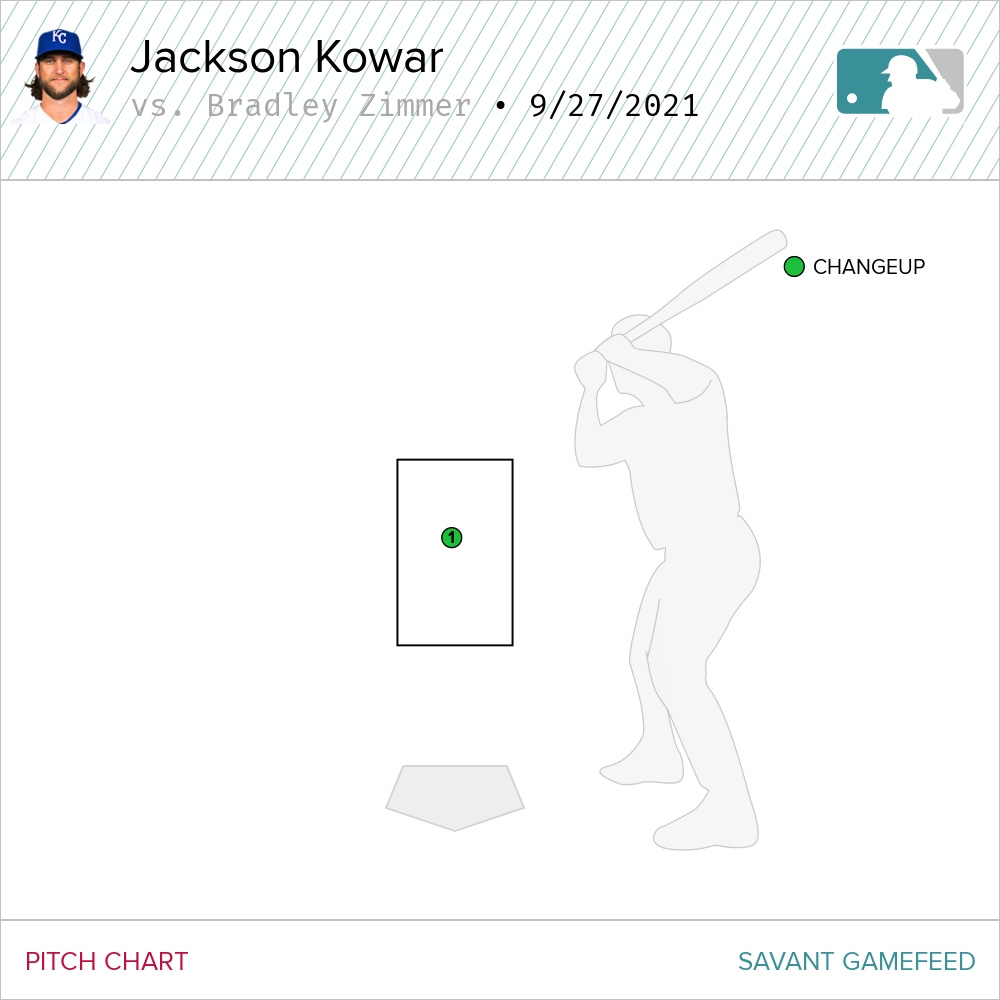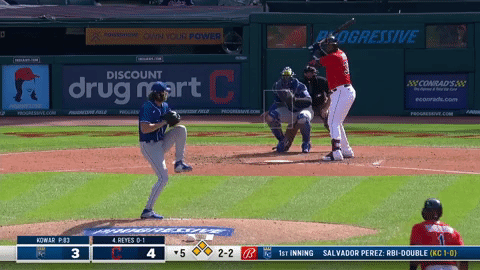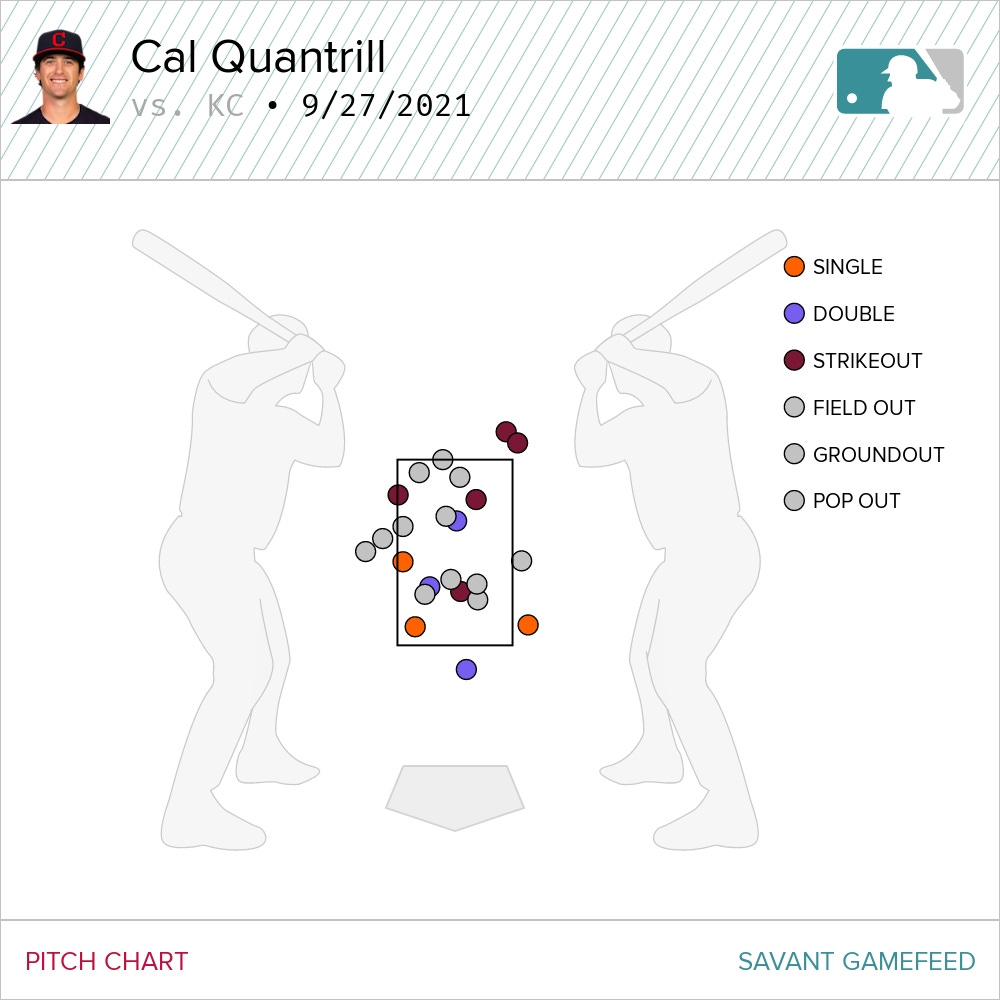Kowar Gives Reason to Shake Head and Dream a Little
It was another rough one for the Royals righty, but he continues to also show the upside, which is at least something.
There’s enough you see in Jackson Kowar that lets you believe, even if just a little, that he can be a top of the rotation pitcher. The 96+ on his fastball stands out when he gets to it. The changeup that can be absolutely nasty stands out when he locates it. The slider looks like it’s a pitch that can be something very good for him as he continues to hone it and get it closer to a consistent above average pitch.
But there’s also enough you see that makes you wonder if he can ever be good enough to be a big league pitcher. He just doesn’t throw enough strikes, pretty simply. He’s only thrown 60 percent or more strikes in a game twice in his now eight outings and those were his first two back from AAA. The first of those games was against yesterday’s opponent, the Indians and the second was against the Orioles in the game he struggled in the first and righted the ship pretty quickly.
And yesterday was a great example of all of this from Kowar. While he didn’t walk his first batter until the bottom of the third (and that was on a borderline call), he did fall behind quite a bit. He wasn’t throwing enough first pitch strikes and he was behind in the count a lot, especially early in the game. But, as we’ve talked about so much, it’s not just about not throwing strikes. It’s about not throwing quality strikes.
Just looking at the first batter he faced, he gave Myles Straw a cookie on 1-0 that Straw hit to right field.
Then in the second, Bradly Zimmer got a changeup that just sat in the middle of the plate.
You can’t live there. Then after the Royals tied the game in the top of the third, his third pitch of the bottom of the third was a changeup that was left in a crushable spot for Amed Rosario.
So he’s leaving too many pitches in the middle of the plate. But then at times, he also shows some absolutely nasty stuff. This changeup to Jose Ramirez in the third is almost unfair. It’s got that screwball movement on it.
And he used the fastball perfectly to set up the changeup to Franmil Reyes on the very next batter. Look where this changeup goes. It’s not as great of a spot as the one to Ramirez, but he used the fastball to make it nearly impossible for Reyes to pull the trigger.
And this was the walk in the third, but ball four to Bradley was absolutely a strike and a perfectly placed pitch that a minor league umpire called up simply missed.
He had an outstanding fourth inning, but in the fifth, the lineup turned over a third time and the first three batters reached. I don’t think he was truly terrible in the inning. Straw had a soft single that just got through. Ramirez hit a ball that caused Nicky Lopez to try to get the runner at second, but it was in the shift so he couldn’t get there in time when he should have gone to first for the out. But what I liked is that he didn’t lose it against Reyes. He did get him to chase a high fastball and then put a perfect fastball right on the edge for his final pitch of the game.
In all, he went 4.1 innings, threw 84 pitches and 49 strikes (that’s 58.3 percent, which is his third best strike percentage in his eight starts). He made some brilliant pitches and some terrible pitches. He ended up giving up five runs on seven hits, which is obviously way too many of each, but one walk is a nice change of pace for him. It’s about as telling as possible that his line lowered his season ERA. It’s a learning experience. For now.
With young pitching, it’s very easy to see what you want to see. You can see the trouble with both command and control and wonder what he can do to even become passable in the big leagues. When you can’t throw strikes, the bullpen isn’t even really an option even though the stuff is obviously good enough to thrive in a late inning role. So you just think that it’s hopeless. But you can also see the positives like the changeup when it’s good or even when he can put a 97 MPH fastball right on the black.
And you think if he can just do that more often or throw the nasty changeup just off the plate more often or find that slider more often that you’re looking at one of the highest ceiling pitchers in the game. For now, I think it’s more than okay to look at what he is and think about what he can be. To think about if he can figure out how to consistently locate the changeup and get whiffs like he did in the minors. To dream on the fastball becoming a pitch that lives on the edges and the top of the zone to get whiffs from the best big leaguers.
But at some point, the results do need to come. I’m personally okay with them not being there yet. This season became not about results about the time they dropped below .500 and never rebounded. But, like Brady Singer, if he comes to spring training and looks like the same pitcher, I’m going to be very disappointed. The Royals aren’t depending on Kowar or Singer or Kris Bubic or Daniel Lynch or Jon Heasley or any of the young starters, but they are depending on some of them figuring it out, which is a good position to be in. But it would be a better position to be in if more of them figured it out than didn’t. So for now, let’s dream on the good from Kowar, but be acutely aware that it’s not going to be about dreaming soon enough.
The Bats Weren’t Enough Anyway
If you’ve ever wondered why I love pitching up so much, just watch Cal Quantrill yesterday against the Royals bats. He was up even with his slider and getting tons of whiffs and weak contact. But look at the results against him.
He did allow a soft double to Kyle Isbel on one of the pitches up, but the rest were outs. Everything else he allowed was on pitches down in the zone. He used the top of the zone so well yesterday and continued his run of good pitching even though he was beaten a couple times by Salvador Perez, but sadly not for a home run. This double was a nice piece of hitting:
But, as has been the case far too often lately, it’s a matter of missed opportunities for the offense.
I’ll go through the list as I do far too often. They left Perez on second in the first. He was there with one out. They left Andrew Benintendi on second in the third. He was there with two outs. They left Adalberto Mondesi on second in the fourth. He was there with nobody out. Then they didn’t have a base runner until Ryan O’Hearn singled to start the seventh, but he was erased a couple pitches later on a double play ground ball.
As a whole, the offense went 1 for 9 with runners in scoring position, so even though they only left three on base, it still feels like they could have scored some more if they could have gotten a big hit. But maybe the bigger waste is that the Royals had 11 at bats end when they were either ahead in the count or the count was full and they had just one hit in those 11 at bats. That’s not something the Royals have struggled with significantly this year. Coming into yesterday, they’d hit .283/.443/.480 while the league was at .283/.476/.509. That’s a bit under, but not significantly so.
Still, when you see guys in hitter’s counts significantly get beaten, it gets demoralizing. No at bat was more frustrating than O’Hearn in the fourth after Mondesi singled and stole second. He was ahead 3-0 and swung at a sinker at the top of the zone and hit a lazy popup to third. The next two batters both popped out as well, but something about a runner at second with nobody out and a 3-0 count to the next batter screams the start of a rally and that was taken away.
But now, the road slate is completed for the Royals. They finished 35-46 away from Kansas City and got there in such a weird way. I mentioned this on Twitter yesterday, but they started 13-13 away from home. Then they went 2-18 over their next 20. And finished up 20-15 over their final 35. Just like happens so often for the Royals, it’s one stretch that ruins everything.














Does Kowar have 2 fastballs? One that is straight and gets hammered? And another that moves and will definitely play? If the latter, and with that changeup, and allowing the slider to play, we do have a high ceiling young pitcher who is making understandable adjustments due to the higher quality of big league hitters. It took Hosmer/Moose/Cain/Esky a year or more to hit their stride. Patience and, as you so aptly do, noticing the potential and improvements, is key. So, next year, we stick with them, let (hopefully most or all of them) work out the kinks. And we let the Big 3 come up from Omaha and work their their adjustment period, hoping that 2 or even all 3 of them are the real deal, but still understanding that it can take a year to really settle down. And - best case - voila - the next championship core, mostly/entirely homegrown due to great drafting and development - and we have met Sherman's (and our) dream - to have a sustainable great team, that can compete and win championships - without the great drop offs - even though next year will be like the first year Hosmer and company came up - lots of promise while working out the kinks - very exciting, with some further patience required.
I'm a big fan of Heasley, mainly for the fact that he appears to be able to command the strike zone. Which not a lot of these young guys have shown that ability to yet. If you had to pick one right now. Heasley or Kowar as the best big league career? Kowar's got the stuff and potential but no ability to consistently command the zone. Maybe we haven't seen enough of Heasley to know for sure but he's appeared in control on the mound. I'm worried some of the shine is quickly coming off Kowar for any potential trade should they go that route. While the results don't have to be there yet.....most highly regarded rookies don't have an 11+ era after 7-8-9 starts now. Hope for the best, but a lot of concern here I think. Get into the offseason with a coach you trust and get it fixed Kowar! lol